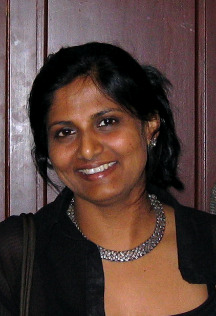Priyamvada Natarajan facts for kids
Quick facts for kids
Priya Natarajan
|
|
|---|---|

Natarajan at KITP, Santa Barbara
|
|
| Born | 1969 (age 56–57) Coimbatore, Tamil Nadu, India
|
| Alma mater | MIT, University of Cambridge, Trinity College, Institute of Astronomy |
| Scientific career | |
| Fields | Cosmology, theoretical astrophysics |
| Institutions | Yale University (professor) |
Priyamvada (Priya) Natarajan is a brilliant scientist who studies the universe. She is a professor of astronomy and physics at Yale University. Dr. Natarajan is famous for her work on mapping dark matter and dark energy. These are mysterious parts of our universe that we can't see directly. She also studies supermassive black holes and how they grow. She wrote a book called Mapping the Heavens: The Radical Scientific Ideas That Reveal the Cosmos. You might have seen her on TV shows like Black Hole Apocalypse on PBS, where she shares her amazing discoveries.
Contents
Early Life and Interests
Priya Natarajan was born in Coimbatore, Tamil Nadu, India, in 1969. Both of her parents were academics, meaning they worked in universities. She grew up in New Delhi. As a child, she loved visiting the Nehru Planetarium Delhi. She was always fascinated by maps, both of Earth and of the stars.
Education Journey
Dr. Natarajan studied at some of the world's best universities. She earned her first degrees in physics and mathematics from M.I.T between 1986 and 1991. She then received a Master of Science degree from the Massachusetts Institute of Technology.
Later, she moved to England to study theoretical astrophysics. She earned her Ph.D. from the Institute of Astronomy at the University of Cambridge in 1998. While there, she was a member of Trinity College, Cambridge. Before joining Yale, she also worked as a researcher in Canada.
Exploring the Universe: Her Research
Dr. Natarajan's research helps us understand the biggest mysteries of the universe. She explores how galaxies and black holes form and grow. Here are some of her main areas of study:
Gravitational Lensing: Cosmic Magnifying Glasses
One of her key areas is gravitational lensing. This is when light from distant objects bends as it passes by very massive objects, like huge groups of galaxies called clusters. It's like these clusters act as giant magnifying glasses in space. Dr. Natarajan uses this effect to map out where dark matter is located. Dark matter is an invisible substance that makes up a large part of the universe.
Understanding Black Holes
She also spends a lot of time studying black holes. These are regions in space where gravity is so strong that nothing, not even light, can escape. She focuses on supermassive black holes, which are millions or even billions of times heavier than our Sun. These giant black holes are found at the center of most galaxies. Dr. Natarajan researches how these black holes form and grow over cosmic time.
Dark Matter and Dark Energy
Dr. Natarajan's work is crucial for understanding dark matter and dark energy. Dark matter doesn't interact with light, so we can't see it. Dark energy is a mysterious force that is causing the universe to expand faster and faster. Her research helps scientists create models to understand these invisible components of the cosmos.
Using New Technologies
She also uses new tools like Machine Learning to help her research. This involves teaching computers to find patterns in huge amounts of data from telescopes. This helps scientists make new discoveries about galaxies and black holes.
Awards and Recognitions
Dr. Natarajan has received many honors for her important work. In 2008, she was awarded the Emeline Conland Bigelow Fellowship. The next year, in 2009, she received a Guggenheim Fellowship, which is a very prestigious award. She was also recognized by the Global Organization for the People of Indian Origin for her academic achievements.
She was elected a fellow of the Royal Astronomical Society in 2008. In 2010, she became a fellow of the Explorers Club, and in 2011, a fellow of the American Physical Society. These are all groups that recognize top scientists.
In 2023, she was elected to the American Academy of Arts and Sciences. In 2024, she was named a Fellow of the American Astronomical Society. This was for her "seminal contributions" to understanding dark matter and black holes. She also developed new ways to map dark matter using gravitational lensing.
Most recently, in 2024, Time magazine named her one of its hundred most influential people. This shows how important her work is to the world.

